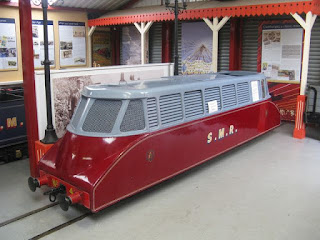I chose the colour 'Regal Blue' from the Games Workshop Citadel range of paints. Four coats of this applied with a flat brush built up sufficient colour depth, with little sign of brush marks. The solebar and roof were painted using Vallejo black (suitable toned down) and Humbrol grey respectively.
Following a coat or two of Johnsons 'Kleer' over the areas in question, lining came from Fox transfers (Royal Mail TPO lining!) and the crests an old set by SMS, I think they are Caledonian Railway examples. Inside the interior walls are the original grey primer and the seats and floor suitable shades from the Citadel 'Foundation' range.
Following a spray with Citadel 'Purity Seal' varnish, windows were individually cut from 20thou clear styrene to fit within each window opening to give a flush glazed effect. Each pane was touched in around the cut edges using a permanent marker pen to reduce refraction within the glazing material.
The finishing touch for the body were door handles from the 7mm Narrow Gauge Association, secured in place from behind using Araldite. Bogies were refitted and the official photographer summoned to record the completion of the build. I am happy that the full-acrylic paint job stands up against sprayed models with little evidence of brush marks in the underlying paint finish.
Of course, there is something missing, passengers! For some time I had in mind using this coach for an experiment in colour and shade. I had read a theory that passengers in coaches could be painted a dark colour and simply be 'shapes' behind the windows. Just look at the next full size bus or train to pass you at a distance and give this theory some thought....
The figures involved are a set I purchased from Aidan Campbell at a show some years ago, they were an experiment by him in resin casting, from the conversation we had I'm not sure if it is one he repeated. All were legless below the knee. I had previously started to paint these but I had fallen out with them as some of them looked rather odd. Using some cheap Chinese Prieser copies I gave two of the figures new heads, and then got carried away and added the lower parts of their legs, using further oddments, and some genuine Prieser parts to complete this process. Milliput covered the joins and hid a few bodges.
The figures were sprayed with grey primer, then given a coat of flesh colour on their faces, arms hands etc. Once this was dry, a wash of black was applied over the entire figure, seeping into the creases and shadows. This darkened the grey areas and avoided a solid mass of colour.
The real test is what they looked like through the coach windows...
I'll leave readers to judge for themselves on the effectiveness of this treatment. I have the coach in my display cabinet for daily inspection, I do wonder if the upper body clothing could do with a dry brush of light colours, but we shall see, at the moment I feel that it works, certainly for fully enclosed stock.













